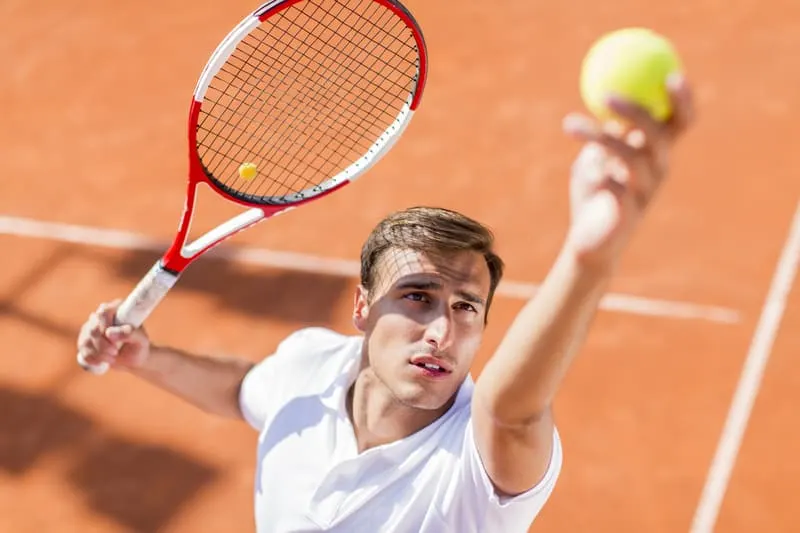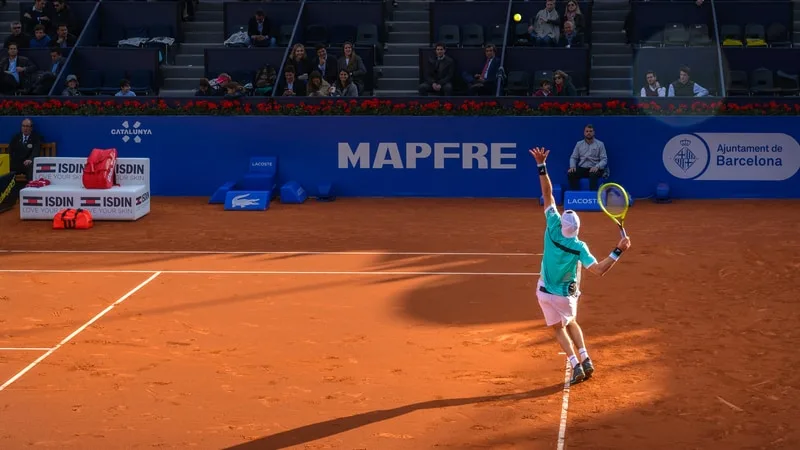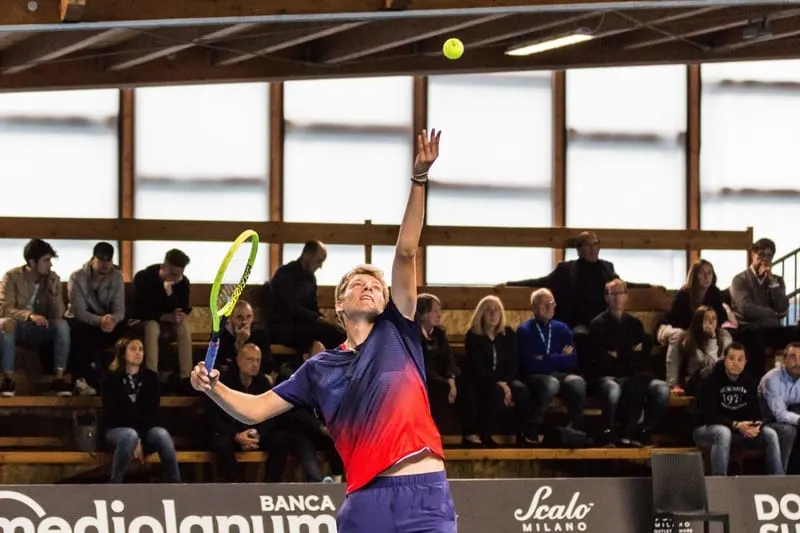
“Life is like a game of tennis; the player who serves well seldom loses”
Ok so this quote is a bit philosophical, but having a good serve is crucial to becoming a successful tennis player.
In fact, it really is the most important shot in tennis.
As the server, you get to choose where to place the ball; out wide, down the ‘T’, into the body. You also get to determine how much spin to put on the ball and what type of spin.
If you can master all the spins, have good consistency, and have effective placement on your serve, you can be a very tricky opponent for anyone.
This article will look at the types of serve, some advice on how to serve well, and some general tips to make your serve become more of a weapon.
4 Types Of Tennis Serve

1. Flat Serve
This is the most common type of serve used by both recreational and professional players. It’s also the serve which you can hit with the most pace, as it has very little spin on the ball, so it’s often used on the first serve.
When hit well with good accuracy and enough power, you can pick up a lot of free points as it’s very hard for your opponent to return.
The downside of the flat serve is that it has a low margin for error, which means it’s harder to get in the service box and over the net.
It can also become quite predictable as your opponent can get used to the pace during a match and use the power against you to hit some good returns.
You’re better off mixing things up with some different types of serves.
2. Kick Serve
The kick serve is a very popular choice as a second serve by most tennis players. It has some topspin and sidespin on the ball which means it will kick to the side and forwards when it lands in the service box.
It’s a great choice of serve on the ad side (if you are a righty) as the ball can kick away from your opponent and force them to hit a backhand (again if they’re a righty)
However, the strength of this serve is that it has a very high margin for error over the net. The topspin on the ball ensures you can comfortably clear the net and the ball will dip down into the service box. It also means you can hit it with some good pace.
This makes the kick serve one of the safest and secure serves to use, and it forces your opponent to stay back, providing you get enough depth into the service box.
3. Topspin Serve
The kick serve and topspin serve are very similar, but the main difference is that the topspin serve won’t have any ‘kick’ sideways, only forwards.
4. Slice Serve
The slice serve is a great choice to mix things up. You chop on the side of the ball as you follow through and the ball will curve to the left (if you’re a righty) in the air.
It’s a great choice of serve to pull your opponent out wide on the deuce side (ad side if you’re a lefty) and leave an exposed open court for you to hit a winner after they return.
It’s also an effective serve into the body to jam your opponent so they can’t hit a return back
The downside of the slice serve is that it has a slower pace because of the spin, so you need very good placement to make it an effective weapon.
Elements of The Tennis Serve
Although the serve is the most important shot in tennis, unfortunately it has the most components to get right in order for it to be effective.
Everything from the feet position, the grip, the toss, to the follow through, all have to be in sync with each other. When the pros serve, it often looks effortless with a natural flow, but don’t be fooled.
Many have spent hours and hours honing their serve to make it effective.
But you can over think things as well, which is fine during practice as you can focus on one area of the serve.
But in a match, you should try and let things come naturally and only think about placement and the type of serve you wish to hit.
Let’s break things down and look at all the elements of the serve, starting the with the grip.
Tennis Serve Grip
The most common choice is the continental grip, but some players use the eastern backhand grip. Here’s what you need to know about the 2 different types of grips.
1. Continental grip
This grip will give you the most power, which is great for the flat serve. Most pros use this and it involves putting the knuckle of your index finger over the 2nd bevel. You can also use it for the other types of serve, but it might not generate quite as much spin.
2. Eastern backhand grip
This option is used less than the continental grip, but it’s great for generating more spin, especially for the kick and topspin serves. The disadvantage is that it won’t generate quite as much power.
For this grip, you put the knuckle of your index finger right over the top bevel.
However, some players use something in between the two. That way you still get power with a fair amount of spin.
Feet Position
After addressing the grip, you should look at your feet position and stance.
If you look at the professional tennis players, you’ll see some are more sideways on at the baseline, where as others are facing more towards the court.
Ultimately, you want to feel comfortable during your serve, but most seem to have their front foot angled towards the right net post at the start of the serve (if you’re a righty)
This way you can hit with a bit more power as you can transition your weight forwards into the court during the serve.
In terms of the actually stance and how wide your feet should be, there are a couple of different options; the platform and the pinpoint stance.
Weight Transfer
During the serve, you want to transfer your weight effectively to generate momentum and more power.
It’s similar to a baseball pitcher who loads the weight on their back leg during the take back and quickly shifts the weight on to the front foot during the throw.
With the tennis serve, you’re really after a rocking motion with your body shifting the weight as you serve. This helps with your serve rhythm and timing.
At the start of the serve, you want to load the weight on your front foot (some players like to have their back foot ankle raised slightly off the ground too).
Then you move your weight to the back foot (it can be helpful to raise your front foot slightly), start your toss and during the service motion move your weight forwards.
The Toss
This is one of the most important elements of the serve.
If you have everything working correctly, but your toss isn’t consistent, you won’t hit good serves.
You want to hold the ball in your fingertips, not in the palm of your hand, as this will help you throw up more accurately and with less spin.
You also want to have the feeling that you’re placing the ball when you toss, not throwing. That way of thinking will help with your consistency.
Some tennis coaches say you should have a high toss, some say a lower one.
Obviously a toss which is high can be affected by the wind more and consistency can be an issue. If the toss is too low you’ll come down on the ball too much and it will just go into the net.
You have to find the right balance for you.
While the best servers can disguise their serves effectively with the same toss, for us mere mortals it’s a bit trickier.
For the flat and slice serves, you want to toss ball up and forwards into the court and a little bit to the right.
For the kick serve, you want to throw the ball more over your head.
Leg Drive
Sometimes this part of the serve can be focused a bit too much.
You often hear coaches say bend your legs more, but there’s more to it than that.
You have to get your upper body working correctly first. If you get a good shoulder turn, and your hips turning properly, you knees will probably bend a bit naturally anyway.
Check out this video below on using your legs during the tennis serve.
Contact Point
The ideal contact point on the serve is just when the ball is starting to descend.
You don’t want to over extend and stretch too much as you will lose power and consistency. You also want to be relaxed when you make contact.
If you get your non dominant hand pointing upwards and straight to the ball at the trophy position, your other arm should come through more naturally and contact will be easier.
5 Tennis Serve Tips To Improve Your Consistency

1. Get Your First Serves In
There’s a well-know tennis expression which goes…
“You’re only as good as your second serve”.
Many players try to hit a hard flat first serve which rarely goes in. This then puts pressure on their second serve as you have to make it or it’s a double fault.
Avoid this situation by aiming to get more first serves in. Take some pace off if you need or mix things up with some slice or kick.
You’ll win more points and more matches if your first serve percentage goes up.
2. Develop a Strong and Reliable Second Serve
Following on from developing a more effective first serve, your second serve also needs to be good. So many recreational players do the ‘pancake’ second serve which is just asking to be put away.
The best way to do this is to learn the kick serve.
This will keep your opponent back in the court, because of the kick on the ball when it hops forward and to the side.
More importantly though, you can aim higher over the net because the ball will dip down into the service box due to the forward spin. This gives you a higher margin of error so you’ll have confidence to put some good pace on your second serve, and not get broken quite as often.
3. Serve out Wide More Often
How often have your seen Federer or Djokovic launch a slice serve out wide which their opponent struggles to get back?
If they do get it back, you’ve got an open court to hit a winner. If you can do this consistently, even if your opponent knows it’s coming, it’s still hard to get back.
Don’t do it all the time, as you need to mix things up with some body serves and down the ‘T’, but serving out wide is extremely effective.
4. Serve To Your Opponents Backhand More Often
Serving out wide is effective, but it’s also a good to focus on your opponent’s weaker side when they’re returning your serve.
In most cases this is the backhand.
In fact, Tom Avery from CTW Academy states that in a survey, 75% of tennis players prefer returning on the forehand side, 20% said that they prefer a backhand, and 5% didn’t mind.
Therefore, you should try and serve to the backhand side more often and exploit the weaker returns.
5. Practice, practice, practice!
Obviously being on the actual court is ideal, but you can do some practice at home
When you’re practicing your serve, you should ALWAYS have a target in mind.
So many recreational players just hit serves without really aiming for anything.
You should be able to hit serves out wide, into the body and down the ‘T’ consistently. Get your placement better and you’ll win more points on your serve.
One good drill I like to use is to stand behind the service box line near the net and just aim for 3 different areas, out wide, down the middle and down the ‘T’. Once I can do this well, I step back a metre and repeat the process, and I keep doing this until I’m back at the baseline.
Also, learning the kick serve will give you more consistency as you can aim higher over the net and the ball will curve down into the service box.
